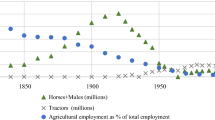Abstract
This paper analyzes the problem of irrigation provision through a public infrastructure in an environment of Asymmetric Information (AI) in a dry area of Ecuador. Due to mismanagement of information and bad definition of goals by the government, a massive interest in acquiring communal lands started in the Peninsula of Santa Elena (PSE) after the government announced the construction plan of a large public irrigation system. During this process, information asymmetries regarding the potential of the irrigation system always prevailed in favor of land buyers. After eight years of functioning of the irrigation system, less than 20 percent of its capacity is in use. This leads to a situation in which the operation and maintenance of the canals is not appropriate, thus endangering sustainability of agriculture itself. This paper starts from the hypothesis that AI has an important impact over the observed pattern of land use and therefore irrigation in the PSE. Under the condition of AI for public goods with costly access, a test was conducted to determine which of the characteristics for an optimal allocation fits in the case of the PSE. Farmer's marginal cost of access to irrigation in connection with the concentration of the property of land by new landholders is considered the relevant informational variable. The most important result of this paper is that the presence of AI induces a scenario in which new landholders demand a smaller quantity of irrigation because of the high marginal costs of farming on big farm plots. A second important result suggests that subsidies to new landowners through the provision of irrigation appear to increase inequality with respect to peasant-commoners.
Similar content being viewed by others
References
Alvarez, S., 1995, From Huancavilcas to Commoners: Inter-Ethnic Relations in the PSE, Ecuador. Ph.D. dissertation, Department of Social Anthropology and History, Autonomous University of Barcelona, Spain.
CEDEGE, 2001, Basic Information About the Capacity of the Canals and Irrigation Infrastructure in the Peninsula of Santa Elena. Internal Reports.
Cremer, H. and Laffont, J. J., 2003, ‘Public goods with costly access’, Journal of Public Economics, 87(9–10), 1985–2012.
Da Ros, G., 1994, ‘Tools for environmental policy’, Journal of Economic Topics. Central Bank of Ecuador.
ESPOL, CEDEGE, University of Florida, and PROMSA, 2001, Study of the Potential for Developing Agro-Industry in the Peninsula of Santa Elena and the Required Resources for its Implementation, Final Report, published by ESPOL, Guayaquil, Ecuador.
FAO, 2002, Crops and Drops, Making the Best Use of Water for Agriculture. Discussion Paper. Rome.
Herrera, P., Matamoros, D., Espinel, R., Cornejo M. P., Van Huylenbroeck, G., Vanrolleghem, P. A., Van Biesen, L., Cisneros, Z., and Duque, J, 2005, ‘Information use and water resources laws and policies in Ecuador’, in J. S. Wallace, P. Wouters and S. Pazvakavambwa (eds.), Hydrological Information in Water Law and Policy: Current Practice and Future Potential. UNESCO/WMO/HELP Programme, Kluwer International Publishers (in press).
Herrera, P., Van Huylenbroeck, G., and Espinel, R., 2004, ‘An application of the contingent valuation method to assess the efficiency of the institutional structure of irrigation property rights: The case of the Peninsula of Santa Elena’, International Journal of Water Resource Development 20(4), 537–551.
Larrea, F. and Varea, A., 1997, Ecology and Sustainable Development. Abya Yala, Quito.
Marcos, J., 2004, Towards a sustainable use of water resources and biodiversity, in the coast: the Albarradas in the PSE. ESPOL.
Munduch, G., Pfister, P., Sögner, L., and Stiassny, A., 2002, Estimating Marginal Costs for the Australian Railway System, Working Paper No. 78, Department of Economics, Vienna University of Economics.
Norman, P., 2003, Efficient Mechanisms for Public Goods with Use Exclusions, Discussion Papers. Department of Economics, University of Wisconsin-Madison, 1180 Observatory Drive Madison.
PIGSA, 2002, Integral Plan for Social and Environmental Management of the Guayas River Basin and the Peninsula of Santa Elena, CEDEGE.
Sandmo, A., 1973, ‘Public goods and the technology of consucmption’, Review of Economic Studies 49, 517–528.
Sandmo, A., 1972, ‘Optimality rules for the provision of collective factors of productions’, Journal of Public Economics 1, 149–157.
Tsur, T., Roe, T., Doukkali, R., and Dinar, A., 2004, Pricing Irrigation Water: Principles and Cases from Developing Countries, Resources for the Future, Washington, DC, USA, pp. 17–19.
Zvika, N., 1994, Property rights and efficiency of public-good mechanisms under asymmetric information. Discussion Papers 1092, Northwestern University, Center for Mathematical Studies in Economics and Management Science.
Author information
Authors and Affiliations
Rights and permissions
About this article
Cite this article
Herrera, P.A., Van Huylenbroeck, G. & Espinel, R.L. Asymmetric Information on the Provision of Irrigation through a Public Infrastructure: The Case of the Peninsula of Santa Elena, Ecuador. Water Resour Manage 20, 431–447 (2006). https://doi.org/10.1007/s11269-006-1292-5
Received:
Accepted:
Issue Date:
DOI: https://doi.org/10.1007/s11269-006-1292-5




